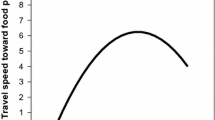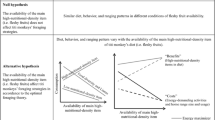Abstract
Previous research has shown that a considerable number of primates can remember the location and fruiting state of individual trees in their home range. This enables them to relocate fruit or predict whether previously encountered fruit has ripened. Recent studies, however, suggest that the ability of primates to cognitively map fruit-bearing trees is limited. In this study, we investigated an alternative and arguably simpler, more efficient strategy, the use of synchrony, a botanical characteristic of a large number of fruit species. Synchronous fruiting would allow the prediction of the fruiting state of a large number of trees without having to first check the trees. We studied whether rainforest primates, grey-cheeked mangabeys in the Kibale National Park, Uganda, used synchrony in fruit emergence to find fruit. We analysed the movements of adult males towards Uvariopsis congensis food trees, a strongly synchronous fruiting species with different local patterns of synchrony. Monkeys approached within crown distance, entered and inspected significantly more Uvariopsis trees when the percentage of trees with ripe fruit was high compared to when it was low. Since the effect was also found for empty trees, the monkeys likely followed a synchrony-based inspection strategy. We found no indication that the monkeys generalised this strategy to all Uvariopsis trees within their home range. Instead, they attended to fruiting peaks in local areas within the home range and adjusted their inspective behaviour accordingly revealing that non-human primates use botanical knowledge in a flexible way.





Similar content being viewed by others
References
Aiello LC, Wheeler P (1995) The expensive-tissue hypothesis: the brain and the digestive system in human and primate evolution. Curr Anthropol 36:199–221
Armstrong E (1983) Relative brain size and metabolism in mammals. Science 220:1302–1304
Barrett L (1995) Foraging strategies, ranging patterns and territoriality among grey-cheeked mangabeys in Kibale forest, Western Uganda. Ph.D. thesis, University College London
Byrne RW (1995) The thinking ape. Evolutionary origins of intelligence. Oxford University Press, Oxford, p 155
Cerella J (1979) Visual classes and natural categories in the pigeon. J Exp Psychol Human 5:68–77
Chapman CA, Chapman LJ, Wrangham R, Isabirye-Basuta G, Ben-David K (1997) Spatial and temporal variability in the structure of a tropical forest. Afr J Ecol 35:287–302
Chapman CA, Wrangham RW, Chapman LJ, Kennard DK, Zanne AE (1999) Fruit and flower phenology at two sites in Kibale National Park, Uganda. J Trop Ecol 15:189–211
Chapman CA, Chapman CA, Rode KD, Hauck EM, McRowell LR (2003) Variation in nutritional value of primate foods: among trees, time periods, and areas. Int J Primatol 24:317–333
Chapman CA, Chapman LJ, Struhsaker TT, Zanne AE, Clark CJ, Poulsen JR (2004) A long-term evaluation of fruit phenology: importance of climate change. J Trop Ecol 21:1–14
Cunningham E, Janson C (2007) A socioecological perspective on primate cognition, past and present. Anim Cogn 10:273–281
De Reffye P, Houllier F, Blaise F, Barthelemy D, Dauzat J, Auclair D (1995) A model simulating above- and below-ground tree architecture with agroforestry applications. J Agrofor Sys 30:175–197
Eckhardt W, Zuberbühler K (2004) Cooperation and competition in two forest monkeys. Behav Ecol 15:400–411
Garber PA, Boinski S (2000) On the move. How and why animals travel in groups. The University of Chicago Press, Chicago London
Harvey PH, Krebs JR (1990) Comparing brains. Science 249:140–146
Herrnstein RJ, Loveland DH (1964) Complex visual concept in the pigeon. Science 146:549–551
Herrnstein RJ, Loveland DH, Cable C (1976) Natural concepts in pigeons. J Exp Psychol Anim Behav Proc 2:285–302
Hladik CM (1975) Ecology, diet and social patterning in old and new world monkeys. In: Tuttle RH (ed) Socioecology and psychology of primates. Mouton, Paris, pp 3–35
Houle A, Vickery WL, Chapman CA (2006) Mechanisms of coexistence among two species of frugivorous primates. J Anim Ecol 75:1034–1044
Janmaat KRL (2006) Fruits of enlightenment. Fruit localization strategies in wild mangabey monkeys. Ph.D. thesis, University of St. Andrews, St. Andrews
Janmaat KRL, Chancellor R (2010) Exploring new areas. How important is long-term spatial memory for mangabey (Lophocebus albigena johnstonii) foraging efficiency. Int J Primatol 31:863–866
Janmaat KRL, Byrne RW, Zuberbühler K (2006a) Evidence for spatial memory of fruiting states of rain forest fruit in wild ranging mangabeys. Anim Behav 71:797–807
Janmaat KRL, Byrne RW, Zuberbühler K (2006b) Primates take weather into account when searching for fruit. Curr Biol 16:1232–1237
Janmaat KRL, Olupot W, Chancellor RL, Arlet ME, Waser PM (2009) Long-term site fidelity and individual home range shifts in Lophocebus albigena. Int J Primatol 30:443–466
Janson C, Byrne RW (2007) Resource cognition in wild primates—opening up the black box. Anim Cogn 10:357–367
Janson CH, Stiles EW, White DW (1986) Selection on plant fruiting traits by brown capuchin monkeys: a multivariate approach. In: Estrada A, Fleming T (eds) Frugivores and seed dispersal. Junk Publishers, The Hague, pp 83–92
Jerison H (1973) Evolution of the brain and intelligence. Academy Press, New York
Krebs CJ (1989) Ecological methodology. Harper, Collins, New York, USA
Lamey M, Grey-Wilson C (1989) The illustrated flora of Britain and Northern Europe. Hodder & Stoughton, London
Martin P, Bateson P (2007) Measuring behaviour, 3rd edn. Cambridge University Press, Cambridge
Menzel CR (1991) Cognitive aspects of foraging in Japanese monkeys. Anim Behav 41:397–402
Menzel CR (1997) Primates’ knowledge of their natural habitat: as indicated in foraging. In: Whiten A, Byrne RW (eds) Machiavellian intelligence II: extensions and evaluations. University Press, Cambridge, pp 207–239
Milton K (1977) The foraging strategy of the howler monkey in the tropical forest of Barro Colorado Island, Panama. Ph.D. thesis, New York University, New York
Milton K (1980) The foraging strategy of howler monkeys. A study in primate economics. Columbia University Press, New York
Milton K (1981) Distribution pattern of tropical plant foods as an evolutionary stimulus to primate mental development. Am Anthropol 83:534–548
Milton K (1988) Foraging behaviour and the evolution of primate intelligence. In: Byrne RW, Whiten A (eds) Machiavellian Intelligence: social expertise and the evolution of intellect in monkeys, apes and humans. Clarendon Press, Oxford, pp 285–305
Normand E, Boesch C (2009) Sophisticated Euclidean maps in forest chimpanzees. Anim Behav 77:1195–1201
Normand E, Ban SD, Boesch C (2009) Forest chimpanzees (Pan troglodytes verus) remember the location of numerous fruit trees. Anim Cogn 12:797–807
Noser R, Byrne RW (2007a) Investigating the mental maps of chacma baboons (Papio ursinus), using intergroup encounters. Anim Cogn 10:331–340
Noser R, Byrne RW (2007b) Travel routes and planning of visits to out-of-sight resources in wild chacma baboons (Papio ursinus). Anim Behav 73:257–266
Noser R, Byrne RW (2010) How do wild baboons (Papio ursinus) plan their routes? Travel among multiple high-quality food sources with inter-group competition. Anim Cogn 13:145–155
Oldeman RAAO (1990) Elements of sylvology. Springer, Berlin
Olupot W (1998) Long-term variation in mangabey (Cercocebus albigena johnstoni Lydekker) feeding in Kibale National Park, Uganda. Afr J Ecol 36:96–101
Olupot W, Waser PM (2001) Activity patterns, habitat use and mortality risks of mangabey males living outside social groups. Anim Behav 61:1227–1235
Perneger TV (1998) What’s wrong with Bonferroni adjustments? Brit Med J 316:1236–1238
Poole RW (1974) An introduction to quantitative ecology. McGraw–Hill, New York, p 532
Potts R (2004) Paleo environmental basis of cognitive evolution in great apes. Am J Primatol 62:209–228
Poulsen JR, Clark CJ, Smith TB (2001) Seasonal variation in the feeding ecology of the grey-cheeked mangabey (Lophocebus albigena) in Cameroon. Am J Primatol 54:91–105
Siegel S (1956) Nonparametric statistics for the behavioral sciences. McGraw-Hill Book Company, New York
Sokal RR, Rohlf FJ (1981) Biometry: the principles and practice of statistics in biological research. W.H. Freeman and Company, San Francisco
Struhsaker TT (1997) Ecology of an African rainforest. University Press of Florida, Gainesville
Tinbergen N (1960) The natural control of insects in pine woods: vol. I. Factors influencing the intensity of predation by songbirds. Arch Neerl Zool 13:265–343
Valero A, Byrne RW (2007) Spider monkey ranging patterns in Mexican subtropical forest: do travel routes reflect planning? Anim Cogn 10:305–315
Van Schaik CP, Terborgh JW, Wright SJ (1993) The phenology of tropical forests: adaptive significance and consequences for primary consumers. Ann Rev Ecol Syst 24:353–377
Vooren AP (1999) Introduction de la bionomie dans la gestion des forêts tropicales denses humides. Ph.D. thesis, Wageningen University, Wageningen
Wallis SJ (1979) The socioecology of Cercocebus albigena johnstonii (Lyddeker): an arboreal rainforest monkey. Ph.D. thesis, University of London, London England
Waser PM (1974) Intergroup interaction in a forest monkey: the mangabey Cercocebus albigena. Ph. D. thesis, The Rockefeller University, New York
Waser PM (1975) Monthly variations in feeding and activity patterns of the mangabey Cercocebus albigena. E Afr Wildl J 13:249–263
Waser PM (1977) Feeding, ranging and group size in the mangabey Cercocebus albigena. In: Clutton-Brock TH (ed) Primate ecology. Academic Press, London, pp 183–222
Waser PM (1985) Spatial structure in mangabey groups. Int J Primatol 6:569–580
Waser PM, Floody O (1974) Ranging patterns of the mangabey Cercocebus albigena, in the Kibale forest, Uganda. Z TierPsychol 35:85–101
Worman C, Chapman CA (2005) Seasonal variation in the quality of a tropical ripe fruit and the response of three frugivores. J Trop Ecol 21:689–697
Zuberbühler K, Janmaat KRL (2010) Foraging cognition in non-human primates. In: Platt ML, Ghazanfar AA (eds) Primate neuroethology. Oxford University Press, Oxford
Acknowledgments
The Wenner-Gren and Leakey Foundation, the University of St Andrews’ School of Psychology, the Schure-Bijerinck-Popping Foundation of the KNAW, the Stichting Kronendak, the Dobberke Stichting voor Vergelijkende Psychology, the Lucie Burger Stichting and the Foundation Doctor Catharine van Tussenbroek provided funding for this research. We thank the Office of the President, the Uganda National Council for Science and Technology, the Uganda Wildlife Authority, the Makerere University Biological Field Station and the Kibale Fish and Monkey Project for logistic support and permission to conduct research in Kibale National Park. We are indebted to J. Rusoke and P. Irumba for invaluable assistance in the field. We are grateful to C. H. Janson, G. Brown, R. W. Byrne, A. Whiten, L. A. Bates, J. Close and three anonymous referees for comments and suggestions that considerably improved earlier drafts of this manuscript. We thank R. L. Chancellor for sharing her feeding data (used to determine preference scores) with us and for her great colleagueship. This study is based on non-invasive observations and complies with the laws of Uganda.
Author information
Authors and Affiliations
Corresponding author
Electronic supplementary material
Below is the link to the electronic supplementary material.
Rights and permissions
About this article
Cite this article
Janmaat, K.R.L., Chapman, C.A., Meijer, R. et al. The use of fruiting synchrony by foraging mangabey monkeys: a ‘simple tool’ to find fruit. Anim Cogn 15, 83–96 (2012). https://doi.org/10.1007/s10071-011-0435-0
Received:
Revised:
Accepted:
Published:
Issue Date:
DOI: https://doi.org/10.1007/s10071-011-0435-0




